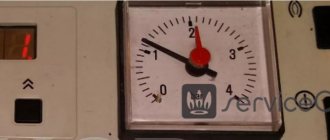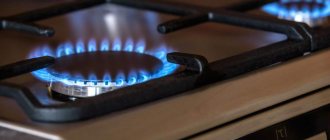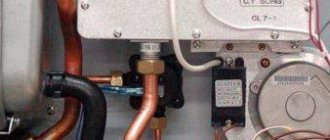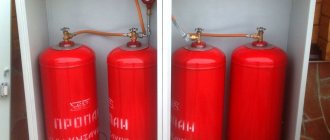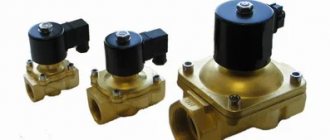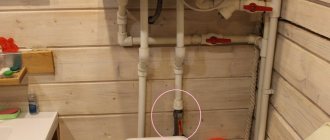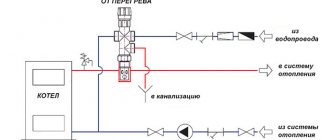Solving problems with boiler attenuation
If the flame goes out not due to malfunctions of the boiler itself, but to other external reasons, you can try to fix the problems yourself. Some models of simple boilers can even be cleaned from soot and soot yourself, but this is a topic for a separate article.
Restoring traction
You can figure out what is clogged - the boiler or the chimney - by disconnecting the corrugated pipe of the exhaust system from the boiler itself. If there is draft in the pipe, then we solve the problem with the boiler by calling a technician. Otherwise, you will have to climb on the roof and look into the pipe. If a blockage is detected, you need to remove those foreign fragments that interfere with the passage of smoke.
Cleaning the chimney is a mandatory procedure to prevent its contamination
If ice is found on the head, it must be carefully chipped off so as not to damage the chimney itself. Be sure to check the cleaning hatches. A sign that cleaning needs to be done is a large amount of soot and soot extracted from the inside of the channel.
You can still reconcile with the blowing of the channel due to strong wind if it happens once or twice during the entire heating season. But if winds are a common occurrence in your area, you should take measures:
- First, you can try to extend the pipe. The high altitude will prevent the wind from pushing the air back with force.
- Secondly, a competent configuration of the head can help out, which will cover the hole on the side from which the winds predominantly blow.
If the electricity goes out
A non-volatile boiler in conjunction with a circulation pump does not consume much. It can be adapted for DC power and switched to battery operation. But this is not suitable for powerful boilers. The only way out is to connect the boiler to an alternative source of electricity, for example, a gasoline or diesel generator.
If the gas pressure decreases
The first thing you need to do is check the gas pipeline at the place where it branches off from the main line. The joints where there are traces of welding, as well as valves and taps, are carefully checked. The specific odor imparted to natural gas at distribution stations will help detect leaks.
The only option is to write an appeal to the appropriate authorities. Contact your neighbors - they most likely have the same problem. Completing a collective petition will help speed up the decision-making process for the natural gas supplier organization in your area.
What to do when the gas boiler goes out and does not light up
Many private houses and apartments are equipped with automatic and semi-automatic gas heating appliances. A boiler is a reliable assistant for heating a room in winter. Even if it was serviced before the heating season, there is still a possibility of it breaking down. Let's look at the reasons why a gas boiler goes out or doesn't light up and how to restore the boiler's functionality if it lights up and goes out.
Why does a gas boiler often go out?
If your parapet, floor or wall convector goes out quite often, you need to find out why this happens and what needs to be done to fix the problem. One of the main reasons for this phenomenon may be a lack of oxygen. This is especially true for boiler models that do not have a draft-increasing hood.
What else can contribute to a lack of air for the boiler:
- The chimney is clogged - in this case it needs to be cleaned;
- Installation of sealed plastic windows, significantly reducing the flow of fresh air into the room;
- Replacement of interior doors, as a result of which the gaps between the floor and the doors have become much smaller;
- Purchasing a powerful hood that takes part of the air flow for itself.
In addition to lack of air, the reason that the flame does not ignite may be a drop in gas pressure. The problem may be on the general backbone (in which case you just need to wait until specialists fix it) or specifically on your network.
To find out if this is true, you should treat all suspicious areas with a sponge and soap suds. Bubbles will appear where there is a leak. It is better to entrust the work of eliminating such a problem to professionals.
A few more reasons why the boiler may turn off:
- Malfunction of sensors - as a rule, these devices monitor the concentration of gases in the boiler and the temperature of the device. If a failure occurs, then naturally the operation of the unit will be disrupted and it will have to be turned off for repairs.
- Poor ventilation of the room - the boiler does not have enough fresh air. The easiest way to solve this problem is to open the door to the room or window. If a flame appears, then you need to think about installing additional ventilation so that the boiler does not constantly go out.
- Failure of the meter, which does not allow gas to pass through in the required quantity. This is usually expressed in the fact that the boiler is very loud, banging and thumping. The numbers on the display do not change smoothly, but in jerks. Here you need to call only specialists. Doing anything with the meter yourself is prohibited.
The reason for the boiler's extinguishing may be related to the pipe. If it burns out, you will have to change it. There is no other option.
Gas boiler does not turn off
In some cases, malfunctions of heating equipment consist in the fact that the gas boiler does not turn off. Gas boilers, whose operation is regulated automatically, turn off when the room temperature reaches a set value. The temperature regime is determined using a thermostat installed in the unit, and the boiler is turned off by a processor built into the electronic control board. If the boiler does not turn off, it means the board or thermostat has failed.
There are some other problems with heating equipment, for example, when a gas boiler knocks. This can happen for various reasons - when debris gets into the combustion chamber through the chimney, when other liquids are used instead of water as a coolant, air locks in the system, low pressure. In any case, it will be difficult to independently determine the cause, so you should contact a company that services gas equipment.
What devices use bimetal?
The scope of application of the bimetallic strip is extremely wide. Almost all devices where temperature control is necessary are equipped with bimetal-based thermostats. This is explained by the design simplicity and reliability of such relay systems. In our usual technology, thermostats are:
- In household heating appliances: stoves, ironing systems, boilers, electric kettles, etc.
- Heating systems: electric convectors, gas and solid fuel boilers with electronics.
- In electric packages there is automatic shutdown.
- In electronics in measuring instruments, as well as in pulse generators and time relays.
- In thermal engines.
In industrial technology, bimetallic plates are installed in thermal relays designed to protect powerful electrical devices from temperature overloads: transformers, electric motors, pumps, etc.
Heating boilers Conord
Rostovsky has a rich history and equally rich experience. Initially, the company was engaged in the repair of road equipment, but in the early 70s it was reoriented to the production of heating equipment.
At the same time, the name “Conord” appeared, which is an abbreviation for the words “Heating Boilers, Non-Standard Equipment, Rostov-on-Don.” The newly born plant began its activities with the production of the DON-16 boiler, famous throughout the USSR.
Heating equipment “Conord”
Today it is a modern enterprise, the technical equipment of which does not in any way remind of its advanced age. The production lines are equipped with the latest high-precision laser machines, imported presses and robots, which allow us to quickly and efficiently produce reliable and affordable devices. The main part of the range consists of gas water heaters, as well as heating boilers - gas, solid fuel and combined.
The range of boilers is quite diverse. First of all, the products differ in the gas burner device used (for short, they call it automatic). Three varieties are available.
Automation AGU-T-M (Russia)
- is cheap;
- does not require power supply (a bimetallic plate is used as a temperature sensor);
- does not impose special requirements on operating conditions and is inexpensive to repair (replacing the bimetallic plate - the only “weak link” - costs only 50 rubles).
This type of automation is quite common in our country and its use is not limited to the Conord brand. You can also see it in such Russian boilers as Mimax and some others.
There is no ignition system in the AGU-T-M, so the boiler has to be started using a lighter or a match.
Automation Euro SIT (Italy)
A boiler with such automation will be more expensive, but it simplifies setting the operating mode and ensures a higher level of safety. It contains:
- igniter with safety device (thermocouple);
- sectional burner with Polidoro tubes;
- gas valve SIT;
- temperature sensor;
- traction sensor
Unlike AGU-T-M, this automation reacts not only to gas shutdown, but also to deterioration of draft in the chimney.
The coolant temperature is set using a thermostat and is maintained automatically by a gas valve.
A piezoelectric spark gap is used to ignite the boiler.
Honeywell (USA)
The automation is of the same type as Euro SIT, only other materials are used for the manufacture of some elements.
An economy mode function has been added, to enter which the ignition knob must be turned all the way.
Conord boilers are also divided into single-circuit and double-circuit.
The former are intended for connection only to the heating system, the latter can additionally perform the function of an instantaneous gas water heater.
Unlike many other boilers with two circuits, Conord does not turn off the heating while using hot water. The 2nd circuit heat exchanger is heated by the smoke pipes. But still, the amount of heat supplied to the heating circuit decreases at this time.
Navien boilers from the largest Korean manufacturer, as a rule, work properly. But it is still a technique, and sometimes it can fail. Let's look at the types of malfunctions of the Navien boiler, as well as ways to troubleshoot problems.
We’ll talk about the functions of an inverter for a heating boiler in this topic.
Do you know why double-circuit gas boilers are purchased more often than single-circuit ones? Using this link https://microklimat.pro/otopitelnoe-oborudovanie/kotly/dvuxkonturnye-gazovye-kotly-dlya-otopleniya-chastnogo-doma.html we will consider the advantages of this type of equipment, as well as installation and selection features.
What models are there?
The main types of Lemax gas boilers are:
- Floor-standing models with steel or cast iron heat exchanger.
- Wall mounted solid fuel.
The solid fuel type of equipment is represented by two models:
- Wood stoves.
- Coal boilers.
Wall-mounted boilers are produced only as double-circuit boilers: they are capable of operating at pressures up to 3 bar. In all cases, Italian automation and circulation pumps are used. Wall-mounted models include a 6-liter expansion tank. This equipment is guaranteed for 2 years. Floor-mounted modifications equipped with steel heat exchangers are also in high demand. For their manufacture, high-strength metal with a thickness of 2 mm is used.
There are 5 models of steel boilers with different capacities:
- Lemax premium.
- Premium nova.
- Gazovik.
- Clever.
- Patriot.
The Premium nova model is considered the most advanced today. Thanks to automatic settings, the device can independently both start a Lemax gas boiler and set optimal operating parameters in the system. The Patriot series devices are characterized by the presence of a closed combustion chamber. They are produced exclusively as single-circuit ones, without the need for electrical power and a chimney. The presence of a 4 mm thick cast iron heat exchanger for the Leader and Wise units extends the service life by approximately 2 years. They are not afraid of various contaminants and the effects of corrosion.
Types of gas boilers
Based on the type of installation, boilers are divided into wall-mounted and floor-mounted units.
Floor-standing gas boilers are characterized by greater power, which means the ability to heat large areas of premises, and longer service lives due to the fact that the heat exchangers for such heat generators are made of steel or cast iron. Floor-standing boilers require a separate room - a furnace room.
Floor standing gas boiler
Wall-mounted boilers are more compact and lighter, which allows them to be installed on the walls of rooms. This type of heat generator is characterized by limited power, shorter service life, and increased requirements for the quality of purification of the coolant and heated water. Gas boiler malfunctions may vary depending on the type of installation.
Wall-mounted gas boiler
By design, boilers are divided into single-circuit, used only for space heating, and double-circuit, intended, in addition to heating, to heat hot water.
Depending on the type of removal of combustion products, heat generators are equipped with systems with natural or forced draft. In the first case, the units are connected to a traditional chimney, which is discharged to the roof of the building, and exhaust gases are released due to natural draft. To ensure this, ventilation ducts are arranged according to certain rules. One of them is that the upper level of the chimney must be located above the roof ridge by at least 500 mm, or at the same level with it at certain distances from the ridge. The reason why the gas boiler blows out may be failure to meet these conditions. Boiler units with natural draft are equipped with open combustion chambers or atmospheric burners, the air for the burner is taken from inside the room.
In the second case, the boilers are equipped with a coaxial chimney, which is a “pipe-in-pipe” design, which is discharged outside through the wall of the room. The air necessary to support combustion comes from the outside pipe through the outer pipe, and combustion products are discharged through the inner pipe. Forced draft boilers have closed combustion chambers.
Traditional and coaxial gas removal systems
And finally, according to the method of ensuring coolant circulation, boiler units are divided into volatile and non-volatile. Volatile boilers have circulation pumps that operate from the electrical network and create pressure in the heating system. In addition, volatile boilers are equipped with sophisticated automation that controls and maintains established operating modes, including an electronic ignition system. Non-volatile heat generators do not require connection to electrical networks, and the movement of the coolant occurs due to natural pressure drops as a result of its heating. Non-volatile boilers can be ignited using a piezoelectric element by pressing a button.
Reasons why the boiler does not turn on
The most common reasons why a gas boiler does not turn on:
- the ignition transformer does not function;
- the gas supply is turned off or the main valve is closed;
- pressure limits;
- burners are clogged.
If it doesn't light up the first time
There are boilers installed on the wall and on the floor. Regardless of the type of equipment, the cause of failure can be both external and internal factors. The following are considered external:
- low pressure in the central pipeline;
- chimney failure;
- the pressure intensity changes;
- wind in the boiler room, or cold.
Internal reasons: failure of electronics (wires, meters), pump and malfunction of heat exchangers.
Another reason for equipment failure is considered to be defects in ventilation in the room. Such malfunctions are inherent in atmospheric boilers. Oxygen during combustion comes from the boiler room.
Other faults
Dual-circuit Zhukovsky models, “Vailant” turn off in the absence of high pressure. This occurs when there is instability during fuel delivery. The protective mechanism is connected due to incorrect adjustment of the boot. Then the boiler stops working. Fuel supply is adjusted.
To understand other faults, it is important to know how the circuit of the device requiring repair works. Each manufacturer has its own characteristics. However, for most models, pumps, meters and main components often break down. In the case of the pump, the burner does not function, and this in turn causes a lack of hot water and heating of the premises. If the pump is humming, the impeller may be jammed. A sign is the humming of the pump.
Loud sounds from the boiler indicate the presence of scale. As a result, the heat exchanger overheats.
Clogged nozzles cause a whistling noise when the heating unit is turned on. You can get rid of the whistling only if you release the accumulated air.
Moisture ingress or condensation are external factors. Water is formed when the coaxial set is not sloped correctly, and condensation is formed in the impulse tube (contains a weak acid solution). The metal case may be damaged and there may be damage inside the main board. Stains appear when exposed to moisture. The protective housing of the board cannot always protect against moisture. If the wires are touched, then most likely the situation is faulty.
Attention! Protecting the board from moisture penetration will ensure a long service life of the equipment itself.
The gas boiler goes out, what to do and how to fix it
If you have a turbine boiler and the flame does not ignite in it, it is worth listening to how it works. If sounds are heard stronger than usual or vice versa, silence - the problem is most likely in the built-in fan, which will have to be repaired or bought a new one.
There are usually 3 options when the boiler does not work:
- The device is completely turned off;
- The device is turned on, the display is on and the indicator is on, but the flame does not ignite;
- The flame ignites but quickly goes out.
First you need to check whether power is supplied to the convector. The reason for its absence may be not only a power outage, but also the operation of a machine on the distribution panel.
If the voltage is OK, you can begin repairs. To do this, unscrew the front panel of the boiler with a screwdriver and remove it or fold it back. Then find the fuse box and check each of them. If a burnt-out one is found, it must be replaced with the same rating. If after these steps the unit starts working, great, but if not, you will have to call a specialist.
If any error is displayed on the convector display, you can read what it means in the technical data sheet of the device.
Some problems that cause the device to turn off can be resolved yourself:
- A clogged sump can be cleaned by first turning off the taps of the device;
- Correct the circulation pump by unscrewing the screw in the center of the pump and releasing the air;
- Add air if the pressure in the tank is too low;
- Repair existing leaks and add water to the system.
This is how you can try to resume the operation of a gas heating boiler of various brands with your own hands, for example, AOGV, Dani, Weber, Aton, AGV.
Gas boiler malfunctions
It turned out that the boiler had gone out and did not want to start. According to safety rules, repairs to a gas heating boiler must be carried out by qualified specialists. However, in some cases, when the arrival of a specialized repair team can be expected for a very long time, you can repair the boiler yourself. Let's look at the main reasons when a gas boiler does not work.
The main symptoms of a gas boiler malfunction are:
- the boiler does not start;
- burner extinguishment;
- the gas boiler does not reach temperature;
- the boiler does not turn off.
What is a bimetallic plate
An element that has the property of deforming (bending) in one direction under the influence of elevated temperature is called a bimetallic plate. From the name you can guess that the plate contains two metals. Each of them has its own coefficient of thermal expansion. As a result, when such a plate is heated, one component expands by a certain amount, and the second by another.
This leads to a bend, the shape of which depends on the difference in temperature coefficients. The rate of deformation is directly proportional to the change in temperature. When the plate cools, it returns to its original position. The plate is a monolithic compound and can work indefinitely.
Review of manufacturers
Gas services, as well as experts in this field, recommend using boilers from the company.
The units are presented in several versions and differ in functional features. Boilers are produced only of floor type. The main difference from other analogues is the affordable price and the lack of electricity required for operation.
Keber boilers are also popular; they are equipped with an automatic safety and regulation system, which ensures precise gas supply and temperature stabilization.
Gas boilers of the AOGV series are quite in demand and are used to heat rooms that have a water heating system with natural or artificial circulation.
(Termotechnik) presents a large selection of boilers and offers floor-mounted, parapet-type, gas and solid fuel units. Many years of experience ensures excellent quality and guarantees product reliability and long service life.
Eliminating problems associated with blowing out the boiler requires special care and responsibility. It is necessary to check all components of the boiler to determine and eliminate the cause of the malfunction. If the recommendations presented do not bring results, it is worth calling the gas service specialists. Remember that quickly getting rid of problems will prevent additional breakdowns and protect not only the entire system, but also the residents of the house.
Watch the video in which a specialist examines one of the most common reasons: why a gas boiler goes out in the wind, what needs to be done, what work needs to be done to improve draft in the boiler:
Gas boilers are the most economical type of heat generators, easy to install and subsequently operate, used in autonomous heating systems. However, like any engineering equipment, gas boilers can sometimes fail, and the most common type of failure is self-extinguishing burner. To understand why a gas boiler goes out or find out the cause of other problems, you need to know about the types of boilers and the principles of their operation.
Gas boiler does not reach temperature
If the gas boiler is working, but the coolant temperature does not reach the required level, the reasons may be the following:
- insufficient air flow necessary to maintain the normal combustion process. When operating boilers with an atmospheric burner installed in combustion chambers, there must be holes or grates at the bottom of the doors leading to these rooms;
- problems with draft due to an improperly constructed chimney or its clogging;
- malfunctions of the boiler itself - the circulation pump does not work, individual automation elements have failed;
- the pressure in the heating system has dropped due to depressurization, insufficient coolant volume, clogging of pipelines with dirt particles, mineral deposits;
- air pockets in heating devices;
- if the boiler is double-circuit, the hot water supply system takes too much energy.
Some gas boiler malfunctions, such as draft problems or lack of air flow, can be corrected yourself. But it is better to entrust the solution to other problems related to the operation of the boiler equipment and heating system itself to specialists.
Gas boiler Conord technical characteristics and features
The thickness of the steel sheets used to make the Conord boiler firebox is 3 mm. The material has a fire-resistant powder coating, thanks to which the service life of the boiler, as the manufacturer assures, is 15 years.
The warranty is valid for 3 years.
The efficiency of boilers of this brand is 90%.
Such a high indicator was achieved due to the installation of turbulators in smoke pipes.
The connections to the pipelines are located on the rear panel of the heat generator.
Their diameters are 50 mm or 2 inches (heating circuit connection) and 15 mm or ½ inch (for the DHW line).
The lowest-power model provides heat generation of 8 kW. The oldest representative of the line has a power of 30 kW. Intermediate values: 10, 12, 16, 20 and 25 kW.
The diameter of the chimney depends on the power of the device. For boilers with a heat output of up to 12 kW inclusive, it is 115 mm, for more powerful ones - 150 mm.
Heat generators of this brand have built-in expansion tanks with a volume of 8.5 liters. The maximum permissible coolant pressure is 6 atm.
An important feature of Conord boilers is the ability to operate at a gas pressure in the main line of only 0.6 kPa (usually the pressure in the distribution gas pipeline is maintained at 1.3 kPa)
Gas boiler does not start
If the gas boiler does not start, the reasons may be the following:
- the electronic or manual ignition system has failed;
- there may be no voltage in the electrical network;
- interruption of gas supply or closed valve on the supply pipe;
- insufficient or excessive gas pressure in the network;
- burner nozzles clogged.
Repair or replacement of the ignition system and cleaning of burner nozzles must be carried out by specialists with special approvals from supervisory authorities.
Damage to the nozzle holes during cleaning can subsequently cause such a phenomenon as the flame tongues coming off the burner, which leads to automatic shutdown of the boiler. A lack or excess of gas pressure in the network can be caused by a malfunction of the fittings, gas meter, etc., and a gas company specialist can also find out the exact cause.
The boiler blows out in a strong wind, what to do in this case
Mechanical heating boilers can go out due to being blown by strong winds. Any atmospheric phenomena - rain, high humidity, low atmospheric pressure, wind can affect draft, causing its excess or deficiency, and also cause reverse draft. Result: the boiler went out. What to do in this case?
The solution to the problem is as follows:
- You can install a special mushroom-umbrella on the edge of the pipe, which will protect the chimney from unwanted influences;
- Or you can increase the pipe itself if its length is not enough.
By the way, this is not the only problem that can arise with the chimney. In addition to blowing smoke, ice may form on the pipe. The reason for this phenomenon is condensation.
The fact is that moisture tends to accumulate and freeze over time, and then become so thick that it simply blocks the access to oxygen and the flame goes out and the boiler turns off.
However, it happens that it is very difficult to knock off ice build-ups and then you have to defrost them. You can purchase a disposable burner with a small can. To melt the ice, you need to light the burner and insert it into the cleaning hatch. When the pipe warms up, the boiler can be put into operation.
Boiler bimetallic plate
Natural gas heating systems are high-risk devices and therefore include various condition monitoring sensors. So, the main safety element is the traction sensor. It determines the correct direction of exit of combustion products, that is, from the combustion chamber towards the chimney. This prevents carbon monoxide from entering the room and poisoning people.
The main component of the draft sensor is a bimetallic plate for a gas boiler. Its operating principle is similar to any bimetal, and the dimensions and parameters of the material are calculated in such a way that exceeding the temperature of 75 degrees in the channel leads to deformation of the plate and operation of the gas valve.
Gas boiler burner extinction
Possible reasons for the burner to go out during operation or immediately after switching on, that is, when the gas boiler does not ignite, may be the following:
- insufficient, excessive or reverse draft;
- the traction sensor is faulty;
- poor thermocouple contact;
- power outages or surges in the network to which the volatile boiler is connected;
- depressurization of gas supply pipeline connections.
Reasons related to draft apply to boilers with an open combustion chamber and a natural exhaust gas removal system, although the effect of blowing out the burner flame by gusts of wind can also occur in coaxial chimneys. All modern boilers are equipped with draft sensors, which are triggered when there is insufficient draft, after which the automation extinguishes the burner. If there is excess draft, the rate of exhaust of combustion products increases, which causes the flame to blow out of the burner; in this case, the automation also cuts off the gas supply. Backdraft or air blowing through the chimney can occur during strong gusts of wind, and the flame in the burner goes out.

